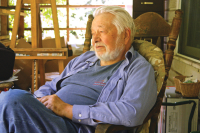Reclaiming the name: Cherokee museum chooses new name, branding
 The new logo uses colors and design elements that represent the unique culture and homeland of the Cherokee people. Museum of the Cherokee People logo
The new logo uses colors and design elements that represent the unique culture and homeland of the Cherokee people. Museum of the Cherokee People logo
When Shana Condill stepped in as Cherokee’s new museum director, she expected questions about the museum’s name — and her instinct quickly proved correct.
“Right when I arrived, which has been about two and a half years ago, our staff was already asking those questions,” she said.
Established in 1948, the downtown museum charged with preserving and telling the millennia-old story of the Cherokee people was known as the Museum of the Cherokee Indian. But on Indigenous People’s Day, celebrated Monday, Oct. 9, the museum announced a new name, and branding to match. The 75-year-old institution will now be known in English as the Museum of the Cherokee People, and in Cherokee as Tsalagi idiyvwiyahi igatseli uweti asquanigododi, which roughly translates to, “All of us are Cherokee people. It is all of ours, where the old things are stored.”
The questions Condill took upon starting the job dealt mainly with the words “museum” and “Indian,” questionable terms for some Cherokee people.
When museums depicting Native peoples began popping up in the 1800s, Condill explained, they treated these tribes as “curiosity cases,” their displays aimed at “documenting a dying culture.” Many Native people hesitate to use the word “museum,” she said. In their minds, the word represents a colonized, exploitative institution.
Related Items
But Condill, who spent her childhood visiting museums with her parents and her adulthood working in them, has a different view. In fact, she wrote her undergraduate thesis on how museums can be a medium to correct stereotypes in Native American representation.
“I feel pretty strongly about reclaiming the word ‘museum’ and making it ours,” she said. “So that was something that I’ve advocated for.”
The next question was what to do about the word “Indian.” It comes from Italian explorer Christopher Columbus, who dubbed the native people “indeos” when he first arrived in the Americas, thinking he’d found a westward route to the Indian Ocean. The name stuck. In federal law, “Indian” is the legal term used in reference to Native tribes. English speakers, sometimes even Native people, use it in conversation. It’s imbedded in the names of tribes —the Eastern Band of Cherokee Indians, for example.
However, in many circles it’s fallen out of favor, as it doesn’t accurately describe who these Native tribes are or where they’re from. It’s a name that was given them, not one they chose. For a long time, Condill said, locals would drop the word “Indian” when referring to the museum, calling it simply “Museum of the Cherokee.”
“I feel it’s inclusive,” graphic designer Tyra Maney, who created the new logo, said of the name change. “With the word ‘Indian,’ some Cherokee people like it, some are indifferent, and others don’t identify with it — I felt like it wasn’t representative of our community if the museum had a name that excluded part of our community.”
Condill reiterated Maney’s opinion that the new name better represents the entire tribe but said the meaning goes beyond that.
“I also just really love the idea of personifying who we are,” she said. “If we keep the word ‘museum’, which is a colonial institution, then add the word ‘people,’ then it makes it impossible to think of us as a dying race.”

Museum staff smile from a parade float during last week’s Cherokee Indian Fair, during which the name change was announced. Museum of the Cherokee People photo
Going along with the museum’s new name is a new visual brand. Like the earlier logo, the new symbol uses an image of a water spider, a creature that, in the Cherokee creation story , brought fire to the people and animals who lived on these lands. However, the new logo trades motifs borrowed from Southwestern tribes for hues and motifs that speak to Cherokee culture.
The color palette comes from the blackberries, evergreens, rhododendrons, touch-me-nots and mountain haze that characterize the Southern Appalachian region. Design elements within the spider’s image pay homage to Cherokee bandolier bag and pottery designs, and to the three worlds Cherokees believe must remain in balance for life to function — Sky World, where birds come from; Middle World, where humans and four-legged animals live; and Under World, where aquatic animals live. Typical designs show an “x” or +” on the spider’s back, but the new logo displays a pinwheel, representing the continuous adaptation and evolution of Cherokee culture.
Condill said she’d been at the museum for about a year when Maney approached her with some preliminary design ideas — making for an unexpectedly emotional moment. For Native institutions, working with designers is often a challenge, Condill said.
“We see a lot of feathers, we see a lot of Southwestern colors, and so to see yourself represented in design is so unique and rare that it’s really moving,” she said.
The new name and logo are now on full display on the museum’s new website, motcp.org .
The rebrand comes at a time of intense planning for the 75-year-old museum. Last year, staff removed a slew of objects determined to be inappropriate for public display in a museum toured by 83,000 people per year — objects looted from gravesites or used in religious rituals, for example. The empty spaces in the display cases were filled with pieces from 36 Cherokee artists. The exhibit, called “ Disruption ,” was slated to end in September, but the artists have all renewed their agreements through the end of December.
After Dec. 29, the museum will close for “a month or two” while it completes its annual inventory and installs a new exhibit in the temporary space. This will be the only exhibit for some time as the museum moves forward with plans for an overhaul of the permanent exhibit, created in 1998. There is no firm date for the exhibit’s projected reopening, but Condill said the board is “super interested in thinking about how we can phase construction” to allow incremental reopening of the display.
“It’s a priority for me and the board that we have some sort of public-facing space that people can go to,” she said.
The museum is also juggling another big project — a 30,000-square-foot archive facility to be built across U.S. 19 from Kituwah Mound. The building will offer expanded space to properly store Cherokee artifacts, in a much-improved environment from the 1976 museum building where they now reside. Construction is expected to start in January 2025 and conclude by the end of 2026.









